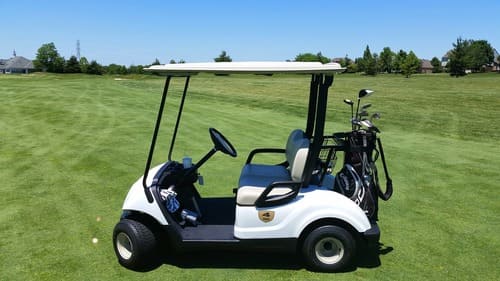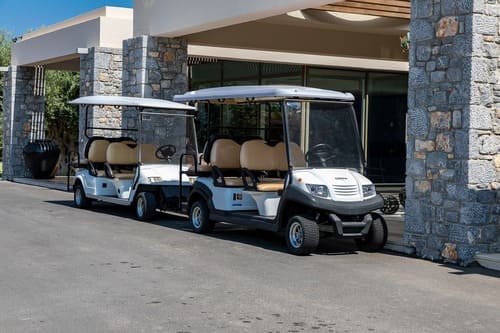Golf carts may seem laid-back, but hidden beneath their quaint exteriors lies a world of speed waiting to be explored.
Are you curious about how fast these four-wheeled wonders can go? Join us on an exhilarating journey as we dive into the exciting realm of golf cart speed basics!
So, buckle up and get ready to experience the need for speed like never before! Let’s hit the accelerator and embark on this thrilling ride together!
Quick Answer
The typical basic golf cart reaches a top speed of approximately 20 MPH (32 KMH). However, factors like age, battery life, and weight load can influence most carts to reach their maximum speed at around 12 to 15 MPH (19 to 24 KMH).
Golf Cart Speed Basics
Golf carts might seem like simple little vehicles used to shuttle golfers around the course, but there’s more to these four-wheeled wonders than meets the eye. If you’ve ever wondered how fast golf carts can go, buckle up as we take a ride through the exciting world of golf cart speed basics!
Types of Golf Carts
Before we dive into the need for speed, let’s explore the different types of golf carts out there. Generally, you’ll come across two main categories: electric and gasoline-powered golf carts.

Electric Golf Carts: These eco-friendly carts are powered by electric motors and rely on rechargeable batteries to get around. They’re known for their quiet operation, smooth rides, and zero emissions, making them a popular choice on golf courses and in residential communities.
Gasoline Golf Carts: On the other hand, we have the gasoline-powered golf carts, which, as the name suggests, run on gasoline. They offer a bit more power and endurance compared to electric carts, but they tend to be a bit noisier and produce emissions.
Electric vs. Gasoline Golf Carts
When it comes to speed, one might wonder if there’s a difference between electric and gasoline golf carts. The truth is, yes, there is! Gasoline carts usually have a slight edge in terms of top speed due to their more robust engines, but electric carts compensate with quicker acceleration and consistent torque delivery.
Factors Affecting Golf Cart Speed
Alright, we’ve reached the juicy part! Golf cart speed isn’t just about pushing the pedal to the metal; various factors play into how fast these carts can go. Let’s break down the elements that influence their speed:
Engine Power: For gasoline golf carts, engine power plays a significant role in determining top speed. The more powerful the engine, the faster the cart can go. In electric carts, it’s all about the strength and capacity of the electric motor.
Terrain and Slope: If you’ve ever driven a golf cart on a hilly course, you might have noticed that it slows down going uphill and speeds up going downhill. The terrain and slope can affect the cart’s speed, as it needs more power to climb uphill and less when going downhill.
Payload Capacity: Loading up your golf cart with bags, equipment, or passengers? Well, that extra weight will impact its speed. Golf carts have a maximum payload capacity, and exceeding it might slow down your ride.
Tire Condition: Just like any vehicle, the condition of the tires matters. Properly inflated and well-maintained tires contribute to better traction and, consequently, better speed.
Environmental Factors: Believe it or not, external factors like temperature and altitude can influence golf cart speed. Carts might perform differently in hot or cold weather, and higher altitudes might lead to reduced engine efficiency.
So, whether you’re zipping around the golf course or cruising through your neighborhood, understanding these speed basics will help you make the most out of your golf cart experience. Stay tuned for more golf cart goodness in the upcoming sections!
Golf Course Regulations
As much fun as it is to speed around in a golf cart, we must remember that safety and responsibility go hand in hand. Golf courses have specific regulations in place to ensure the well-being of players, passengers, and the environment. Let’s take a closer look at some of the key aspects of golf course regulations when it comes to golf cart usage.
Maximum Speed Limits on Golf Courses
Just like any road, golf courses have speed limits too. While it might not be posted on signs like traditional streets, most courses have established speed limits that are expected to be followed. The typical maximum speed for golf carts on a golf course is around 15 to 20 miles per hour (24 to 32 kilometers per hour).
These speed limits might vary depending on the course’s layout, terrain, and potential hazards. Some areas, such as near the clubhouse or in crowded zones, might have reduced speed limits for safety reasons.
Safety Measures and Rules for Golf Cart Usage
Golf course operators and staff prioritize the safety of everyone using their facilities. They often have strict rules in place to ensure the safe operation of golf carts. Here are some common safety measures and rules you might encounter:
Seat Belts: Most modern golf carts are equipped with seat belts, and it’s essential for all passengers to wear them. Seat belts can significantly reduce the risk of injury in case of sudden stops or accidents.
Designated Paths: Golf courses often have designated paths or cart lanes to follow. Staying on these paths helps maintain the course’s integrity, prevents damage to the turf, and avoids accidents with other golfers.
No Reckless Driving: Just like on public roads, reckless driving is a big no-no on golf courses. Sharp turns, sudden accelerations, and abrupt stops can be dangerous, especially when other golfers are nearby.
No Drinking and Driving: It’s crucial to adhere to the same rules for driving under the influence on a golf course as you would on public roads. Never operate a golf cart while under the influence of alcohol or any substances that impair your judgment.
Single Rider Policy: Some golf courses enforce a single rider policy, especially during busy times, to reduce the risk of accidents and make the game more enjoyable for all players.

Impact of Speeding on Golf Courses
Speeding on a golf course can have several negative impacts, both on the course and the overall experience for everyone involved. Here are a few consequences of speeding:
Turf Damage: Speeding carts can tear up the grass, leaving behind unsightly divots and damaging the course’s delicate landscaping.
Accident Risks: Higher speeds increase the likelihood of collisions with other golf carts, golfers, or course obstacles, leading to potential injuries and damage.
Noise and Disturbance: Excessively fast-moving carts can be noisy and disruptive to other players trying to enjoy their game in a peaceful environment.
By adhering to golf course regulations, respecting speed limits, and practicing safe driving habits, we can ensure that everyone has a fantastic time on the course while keeping accidents and disturbances at bay. Remember, the journey is just as enjoyable as the destination!
Street-Legal Golf Carts
Golf carts aren’t confined to the green fairways anymore; they’ve hit the open road and become a popular mode of transportation in various neighborhoods and communities. Have you ever wondered about those nifty street-legal golf carts cruising around town? Let’s explore what makes them different, their speed limits, and what it takes to make them street-legal.
Differentiating Golf Course Carts and Street-Legal Golf Carts
While golf course carts and street-legal golf carts might look similar, they serve distinct purposes and have some key differences:
Golf Course Carts: These are the standard golf carts you’ll find on golf courses. They are designed primarily for use within the confines of the course and have a limited top speed to ensure safety and protect the turf.
Street-Legal Golf Carts: On the other hand, street-legal golf carts are modified versions that comply with local regulations, allowing them to be driven on public roads with speed limits that go beyond the typical golf course cart limits.
Speed Limits for Street-Legal Golf Carts
Street-legal golf carts typically have higher speed capabilities compared to their golf course counterparts. The maximum speed for street-legal golf carts can range from 20 to 25 miles per hour (32 to 40 kilometers per hour) in most areas. It’s essential to adhere to these speed limits just like any other vehicle to ensure road safety.
Requirements and Modifications for Street-Legal Use
Turning a standard golf cart into a street-legal vehicle involves meeting certain requirements and making specific modifications. While the exact regulations vary by region, some common modifications and requirements include:
Safety Features: Street-legal golf carts must be equipped with essential safety features, including headlights, taillights, turn signals, brake lights, mirrors, and a windshield.
Seat Belts: Just like regular cars, seat belts are a must for street-legal golf carts to ensure passenger safety.
Horn: To alert pedestrians and other drivers, a functioning horn is typically required.
Vehicle Identification Number (VIN): Some regions may require a VIN or a unique identification number for proper registration and identification of the cart.
License and Registration: Street-legal golf carts must be registered with the appropriate local authorities, and drivers may need a valid driver’s license or a special permit to operate them on public roads.
Insurance: Depending on local regulations, insurance may be required for street-legal golf carts to protect both the driver and other road users.
Speed Controller Adjustment: In some cases, the golf cart’s speed controller may need to be adjusted or limited to comply with speed regulations.
It’s essential to research and understand your area’s specific requirements and regulations before converting a golf cart for street use. Additionally, consulting with a professional or a local DMV office can help ensure that your modifications meet the necessary standards for a safe and legal street-legal golf cart.
So, the next time you spot a golf cart rolling through town, remember that it might not be bound for the course but instead taking its place on the roads with the big boys!
Enhancing Golf Cart Speed
Are you itching for a little more speed in your golf cart experience? While golf carts are designed for leisurely rides, there are legitimate ways to give them a speed boost and enhance your overall driving experience. Before you hit the gas pedal, let’s explore some safe and effective ways to increase golf cart speed.
Legitimate Ways to Improve Golf Cart Speed
Upgrading Batteries and Motors: One of the most significant factors affecting golf cart speed is the power source. If you have an electric golf cart, upgrading to high-quality, higher voltage batteries can provide more energy to the motor, resulting in improved speed and performance. Similarly, swapping out the stock motor for a more potent one designed for higher speeds can make a noticeable difference.
Performance Controllers: Installing a performance controller, also known as a speed controller, can fine-tune the power delivery to the motor. This allows for better acceleration and increased top speed. These controllers offer programmable options, so you can find the perfect balance between speed and efficiency.
Tire and Wheel Upgrades: Believe it or not, the type of tires and wheels you use can impact your golf cart’s speed. Low-profile tires with less rolling resistance and lighter aluminum wheels can contribute to a smoother ride and a slight increase in speed.
Important Considerations for Modifications
While it’s tempting to rev up your golf cart for a thrill, it’s crucial to keep some essential considerations in mind:
Safety: Any modifications made to a golf cart should prioritize safety. Ensure that your upgrades don’t compromise braking efficiency or stability, as safety should always be the top priority.
Terrain and Usage: Consider how you primarily use your golf cart. If it’s for golfing on a hilly course, focusing on torque and hill-climbing ability might be more beneficial than just top speed.
Warranty and Manufacturer Guidelines: Modifying your golf cart might void its warranty or violate the manufacturer’s guidelines. Be aware of potential consequences before making any changes.
Adhering to Local Laws and Safety Concerns
Before you hit the accelerator and show off your souped-up golf cart, it’s essential to check local laws and regulations regarding modified golf carts. Different regions have specific rules about golf cart modifications and speed limits, especially for street-legal carts. Make sure that your modifications comply with local laws to avoid legal issues. This also ensure your safety and the safety of others on the road.
Remember, while enhancing golf cart speed can be exciting and enjoyable, it’s essential to strike a balance between performance and safety. Whether you’re cruising on the course or exploring your community, a well-maintained and properly modified golf cart can provide a smooth, thrilling ride while still adhering to local laws and safety concerns. Happy driving!
Alternative Uses of Golf Carts and Their Speed
Golf carts have proven to be incredibly versatile vehicles, transcending their traditional role on golf courses. As their popularity soars, they are finding diverse applications in various settings, each with its own unique speed requirements. Let’s explore some alternative uses of golf carts and how their speed plays a crucial role in these different scenarios.

Golf Carts in Residential Communities
In many residential communities, golf carts have become a preferred mode of transportation for residents and visitors alike. These low-speed vehicles (LSVs) provide a convenient and efficient way to get around within the neighborhood. Speed limits for golf carts in residential areas are typically lower than those on public roads. This ensures pedestrian safety and maintain a tranquil atmosphere. Common uses for golf carts in residential communities include:
Transportation: Residents use golf carts for short trips to visit neighbors, access community amenities like pools or fitness centers, or simply enjoy a leisurely ride around the neighborhood.
Security Patrols: Some gated communities employ golf carts for security patrols due to their quiet operation and easy maneuverability.
Green Transportation: Golf carts contribute to reduced carbon emissions and noise pollution in residential areas, promoting a greener and more sustainable mode of transportation.
Golf Carts for Transportation in Resorts and Parks
Resorts, amusement parks, and recreational areas have recognized the practicality and charm of golf carts for moving people around efficiently. Their speed, tailored to the specific environment, ensures smooth transportation and enhances the visitor experience. Applications of golf carts in these settings include:
Shuttle Service: Resorts and amusement parks use golf carts as shuttle vehicles. Transporting guests from parking lots to various attractions within the facility.
Touring and Sightseeing: Golf carts offer a comfortable and intimate way for tourists to explore expansive resorts, botanical gardens, and parks.
Accessibility: These carts cater to visitors with mobility challenges, making it easier for them to access different areas of the resort or park.
Industrial and Commercial Applications of Golf Carts
The utility of golf carts extends beyond recreation and leisure; they find numerous applications in industrial and commercial settings, where speed requirements can vary depending on the specific task. Some common uses of golf carts in these contexts are:
Material Handling: Golf carts equipped with cargo beds or utility boxes are used to transport tools, equipment, and supplies in factories, warehouses, and large commercial spaces. Speed is often adjusted to match the safety requirements of these busy work environments.
Campus Transport: Universities and large corporate campuses utilize golf carts for convenient and eco-friendly transportation between buildings and facilities.
Hospitality Services: In hotels and event venues, golf carts assist with luggage transport and guest transportation, requiring a balance of speed and safety.
As golf carts continue to evolve and adapt to various needs, they demonstrate their versatility as reliable, eco-friendly, and efficient vehicles in diverse settings. With their adjustable speed capabilities, they fit seamlessly into residential, recreational, industrial, and commercial landscapes. Providing a convenient and eco-conscious means of transportation for countless people around the world.
Safety and Golf Cart Speed
While golf carts may seem like harmless fun, safety should always be a top priority when operating these vehicles. Understanding the risks associated with speed, utilizing safety features, and following safe driving practices are crucial for a secure and enjoyable golf cart experience.
Understanding the Risks of Speeding
Speeding in a golf cart can lead to several potential risks and hazards:
Loss of Control: As with any vehicle, excessive speed can lead to a loss of control. Especially when navigating turns or uneven terrain on the golf course or other areas.
Increased Stopping Distance: Faster speeds require more time and distance to come to a complete stop. Failure to slow down in time can result in collisions with other carts, obstacles, or pedestrians.
Turf Damage: On golf courses, speeding golf carts can cause extensive damage to the turf. This creates unsightly divots and adversely affecting the course’s aesthetics.
Higher Risk of Accidents: Speeding increases the likelihood of accidents, leading to injuries for passengers, other golfers, or property damage.
Importance of Seat Belts and Safety Features
To mitigate the risks associated with golf cart speed, it’s essential to use seat belts and other safety features properly:
Seat Belts: Seat belts are a fundamental safety feature in golf carts, just as they are in regular vehicles. They restrain passengers during sudden stops or collisions, significantly reducing the risk of injury.
Brakes and Steering: Regular maintenance of brakes and steering systems ensures they are functioning correctly and can respond effectively to changing conditions.
Mirrors: Golf carts equipped with mirrors provide drivers with better visibility of their surroundings. This helps to avoid collisions and maneuver safely.
Headlights and Taillights: It is important to use headlights and taillights when driving at dawn, dusk, or in low-light conditions. This makes the golf cart more visible to others, reducing the risk of accidents.
Tips for Safe Golf Cart Driving
Follow these tips to ensure safe golf cart driving for yourself and others:

Observe Speed Limits: Always adhere to posted speed limits, whether on the golf course, residential areas, or public roads. Driving at a safe and appropriate speed is essential for preventing accidents.
Avoid Distracted Driving: Stay focused on the road and avoid distractions, such as using mobile phones or engaging in activities that take your attention away from driving.
Mind the Terrain: Slow down when navigating uneven terrain, slopes, or narrow paths to maintain control of the golf cart.
Respect Right of Way: Yield to pedestrians, other golfers, and vehicles when appropriate. Be courteous and patient, especially in busy areas.
Be Mindful of Passengers: Ensure all passengers are seated properly and wearing seat belts before starting the ride.
No Drinking and Driving: Never operate a golf cart under the influence of alcohol or any substances that impair your judgment.
By understanding the potential risks, using safety features, and adopting safe driving practices, you can enjoy the fun and convenience of golf carts while prioritizing the safety and well-being of yourself and those around you. Safe driving habits not only protect you and your passengers but also contribute to a positive and enjoyable golf cart experience for everyone involved.
Future Trends in Golf Cart Speed and Technology
Golf carts, once seen as humble vehicles for the golf course, are undergoing exciting transformations that hint at a dynamic future. From advancements in electric technology to the potential of autonomous driving, let’s delve into the evolving world of golf cart speed and technology.
Advancements in Electric Golf Carts
Electric golf carts have already proven to be a game-changer with their eco-friendliness and quiet operation. Looking forward, we can expect even more remarkable advancements in electric golf cart technology:
Battery Efficiency: As battery technology improves, electric golf carts will benefit from longer-lasting, faster-charging, and more energy-dense batteries. This enhancement will lead to extended ranges and increased power, potentially improving overall speed.
Performance Motors: Electric motor technology is also evolving rapidly. Manufacturers are developing high-performance motors that offer superior torque and acceleration, translating into enhanced speed and better overall driving experiences.
Smart Integration: The integration of smart technologies and connectivity will become more prevalent in electric golf carts. Features like smartphone apps for remote control and vehicle diagnostics will enhance user convenience and accessibility.
Potential Impact of Autonomous Golf Carts
The future of golf carts may be closer to science fiction than you might think. Autonomous driving technology has the potential to revolutionize the golf cart experience:
Self-Driving Capabilities: Imagine hopping into a golf cart and letting it navigate the course autonomously, following a designated route or even analyzing the best path for optimal play. Autonomous technology can take the hassle out of driving, allowing golfers to focus solely on their game.
Enhanced Safety: Self-driving golf carts can be equipped with advanced sensors and AI-powered systems to detect and avoid obstacles, ensuring a safer ride for both passengers and others on the course.
Efficient Course Navigation: Autonomous golf carts can be programmed to follow predefined paths, minimizing turf wear and maintaining the course’s aesthetics more effectively.
Environmental Considerations and Sustainable Golf Cart Solutions
As the world becomes more environmentally conscious, the golf cart industry is responding with sustainable solutions:
Electric and Solar Hybrids: Golf carts that combine electric power with solar panels are already being explored. Solar panels on the cart’s roof can help recharge the batteries while the cart is parked, increasing energy efficiency and reducing the need for grid charging.
Recyclable Materials: Manufacturers are focusing on using recyclable and eco-friendly materials in the production of golf carts, reducing their environmental impact.
Alternative Fuels: Beyond electric power, researchers are exploring other alternative fuels like hydrogen and biofuels to reduce emissions and promote a cleaner future for golf cart transportation.
The future of golf carts is exciting and dynamic. By embracing technological advancements that not only enhance speed and performance but also prioritize environmental sustainability and safety. Whether it’s through electric power, autonomous driving, or eco-conscious innovations, the golf cart industry is on the path to transforming the way we perceive and experience these four-wheeled wonders on and off the course. Let’s tee up for a greener, smarter, and faster ride ahead!
Final Thoughts
In summary, our journey through the world of golf cart speed has been nothing short of thrilling. We’ve explored the different types of golf carts, the impact of speed on golf courses, and the safe and responsible ways to enhance their velocity.
As we peek into the future, the exciting prospects of advancements in electric technology and potential autonomous driving leave us in awe.
Remember, speed should always be balanced with safety and environmental considerations. So, whether you’re cruising on the green fairways or exploring your neighborhood streets, cherish the exhilaration of golf cart speed, but always drive responsibly. Happy carting!






